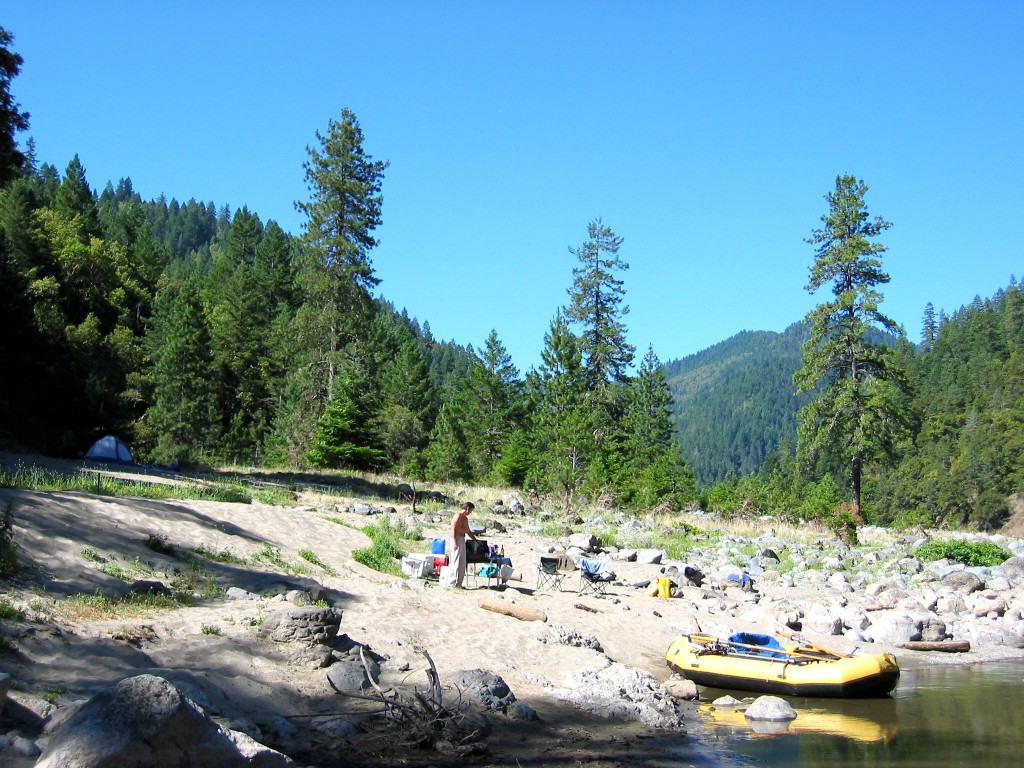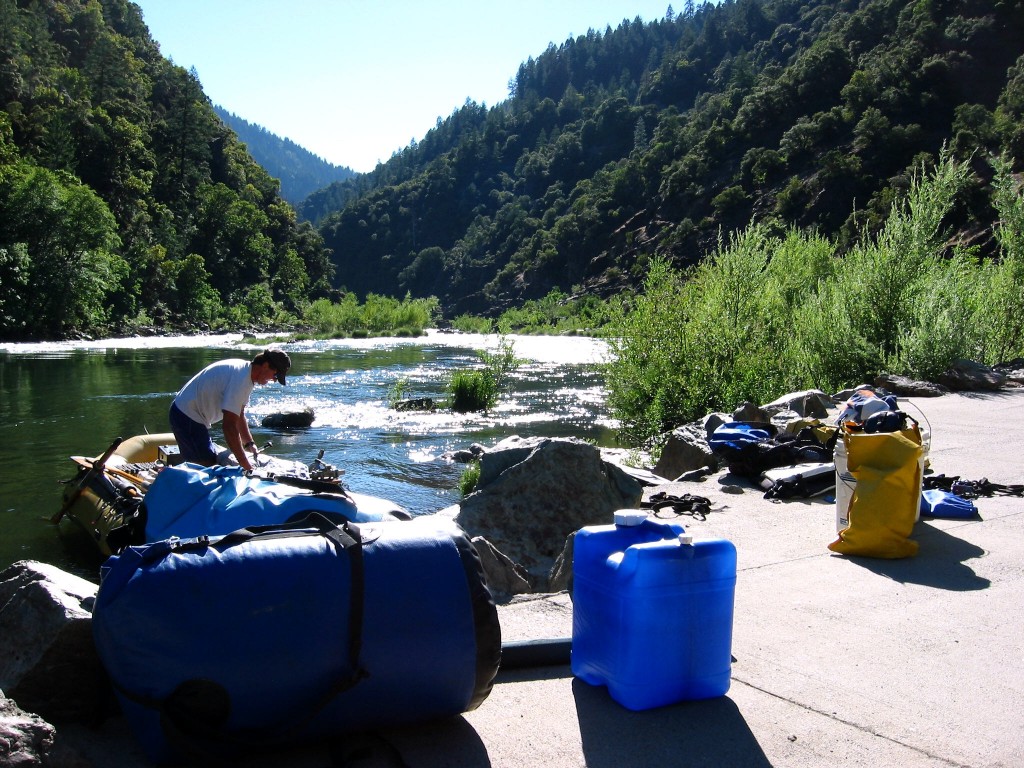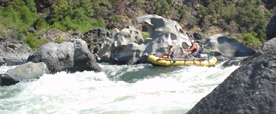Getting Away From Them All
Packing the raft at Grave Creek
July 2006
The pair of grizzled fifty-somethings arrived at the Rogue River boat ramp on touring motorcycles just before 6 p.m. and watched silently for a few minutes as my husband, Jeffrey, and I packed gear into our 13.5-foot raft.
In went three large coolers containing the kitchen and cold food; two rocket boxes containing dry food and personal gear; a camp stove, camp lantern and five gallons of water; two roll-up tables and two folding chairs; two large dry bags, containing clothing, sleeping bags, pads and a tent; and two five-gallons buckets—one for garbage and one a toilet.
Finally curiosity got the better of the bikers and they started firing off questions.
“How do you get back?” By driving over the mountains of the Siskiyou National Forest in our pickup, which will be waiting 34 miles downstream when we arrive day after tomorrow.
“Why don’t you use a 220 Merc?” Because motorboats aren’t allowed in the wilderness canyon of the Rogue and, even if they were, propellers don’t survive rocky, whitewater rivers.
“What happens if you fall out of the boat?” Point your feet downstream to fend off rocks and paddle for shore.
“Did you bring any beer?” You bet!
Twenty minutes later, we shoved off into sun-dazzled water for a honeymoon trip, just the two of us in our little yellow raft with a glorious forecast of hot blue sky days and clear starry nights for the three-day trip, two-night trip.
In the parlance of whitewater aficionados, heaven.
Movie buffs may have seen the Rogue canyon in Meryl Streep’s “River Wild,” John Wayne’s “Rooster Cogburn,” or the 1964 Oscar-winner “How the West Was Won.” Fans of Western novels may know the river from the writings of Zane Grey, whose ramshackle 1920s cabin at Winkle Bar remains a popular stop.
 The canyon is packed with wildlife — including bears, cougars and bald eagles — as well as a colorful and often tragic history. Dilapidated cabins and rusting equipment left by gold miners can been seen here and there. Today the river’s native American heritage is more apparent in place names like Tyee or Illahe than in the sites of long-vanished villages now overgrown with forest. The final battle of the Rogue Indian War, during which white volunteers carried yellow flags that bore in black letters the word “Extermination,” was fought at Big Bend in June 1856.
The canyon is packed with wildlife — including bears, cougars and bald eagles — as well as a colorful and often tragic history. Dilapidated cabins and rusting equipment left by gold miners can been seen here and there. Today the river’s native American heritage is more apparent in place names like Tyee or Illahe than in the sites of long-vanished villages now overgrown with forest. The final battle of the Rogue Indian War, during which white volunteers carried yellow flags that bore in black letters the word “Extermination,” was fought at Big Bend in June 1856.
Jeffrey and I began floating the Rogue 20 years ago in large groups with multiple boats filled with a dozen or more friends and family members. We soon discovered that the larger the group, the smaller the relaxation we experienced because so much time and talk focused on worries we’d hoped to leave behind, such as where should we camp, what time should we have dinner and how early should we get on the river tomorrow?
In a large group, we couldn’t have put on the river at 6:20 p.m. on a Friday night in June. Nor could we have made our way around the river’s first major rapid – the 12-foot drop into churning turbulence at Rainie Falls—a mere 45 minutes later by maneuvering through the narrow adjacent fish ladder. Over the next 3.3 miles, we floated past six separate encampments of rafters and hikers at Whiskey and Doe creeks and the beach at Tyee, where in the pioneer past 300 Chinese miners took more than $5 million in gold dust from the bar.
Thick shadows crawled down the canyon’s forested walls when we claimed the spacious campsite below Wildcat rapid and broke out the beer in celebration. By 8:30 p.m. we had the boat unloaded, the tent erected and the kitchen unpacked. A half hour later our strip steaks grilled over charcoal while fried potatoes and green beans cooked on the gas stove. We rounded out the meal with a salad of baby lettuce with blue cheese vinaigrette and a bottle of Cote du Rhone. While heating the wash water, we gobbled our dessert of chocolate pastries then sat by the fire with cups of Hennessey cognac and studied the Milky Way overhead. At 11:30 p.m., with the dishes washed and the coolers and garbage secured against bears, we crawled into our sleeping bags and conked right out.
Days spent on the river fall into familiar rhythms – making or breaking camp, napping or swimming after lunch, recovering from the dousing in the last rapid or preparing for the roller coaster effect of the next.
The next day the highlight of our wildlife viewing was the sleek otter which ducked below the surface when we approached, pulled a 180-degree turn visible to us in the clear water and then climbed out on rock behind us to watch us with a wary eye until our raft disappeared around the bend. Through our last hot afternoon we saw a half dozen turtles basking on sun-warmed rocks, poised on tip-toe with their necks stretched out fully and their noses tilted toward the sky in a reptile version of yoga’s sun salutation.
As the temperature soared past 100 degrees, we sought relief in the deep cold pools of side creeks, grateful for patches of shade so artfully decorated with clumps of wildflowers—fuzzy yellow balls, bright orange trumpets, lacey white fans – interspersed with deep green ferns.
We found our thrills in the challenging rapids. At Upper Black Bar Falls, Jeffrey crabbed an oar at the top, knocking the raft out of position and into the gut of a huge wave that caught me right in the kisser and filled the boat with water. But he didn’t miss a stroke in Mule Creek Canyon, navigating through the hissing white snake, past deadly Telfer’s rock and across the infamous Coffee Pot like the experienced oarsman he is. And at Blossom Bar, the most difficult rapid of all, the usual shot of adrenaline tripped my heart into a faster beat as the raft surged down a V-shaped slick of green water and into a rock garden strewn with enormous boulders.
A lot of the stress in life comes from the pressure of other people. For the two of us, getting away from them all turns out to be just as important as getting away from it all. And one of the best getaways we’ve found is a honeymoon trip through the Rogue River’s wilderness canyon.
Copyright 2006 © by Beth Quinn Barnard of text and photos. All rights reserved. Reproduction in whole or in part without permission is prohibited.


No Responses to “Getting Away From Them All”